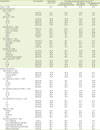1. Committee on Accelerating Progress in Obesity Prevention. Food and Nutrition Board. Institute of medicine. Glickman D, Parker L, Sim LJ, Del Valle Cook H, Miller EA, editors. Accelerating progress in obesity prevention: solving the weight of the nation. Washington, D.C.: National Academies Press (US);2012.
2. Hales CM, Fryar CD, Carroll MD, Freedman DS, Ogden CL. Trends in obesity and severe obesity prevalence in US youth and adults by sex and age, 2007–2008 to 2015–2016. JAMA. 2018; 319:1723–1725.

3. Barlow SE. Expert Committee. Expert committee recommendations regarding the prevention, assessment, and treatment of child and adolescent overweight and obesity: summary report. Pediatrics. 2007; 120:Suppl 4. S164–S192.

6. US Preventive Services Task Force, Grossman DC, Bibbins-Domingo K, Curry SJ, Barry MJ, Davidson KW, Doubeni CA, Epling JW Jr, Kemper AR, Krist AH, Kurth AE, Landefeld CS, Mangione CM, Phipps MG, Silverstein M, Simon MA, Tseng CW. Screening for obesity in children and adolescents: US preventive services task force recommendation statement. JAMA. 2017; 317:2417–2426.
8. Smith AJ, Skow Á, Bodurtha J, Kinra S. Health information technology in screening and treatment of child obesity: a systematic review. Pediatrics. 2013; 131:e894–e902.

9. Ayash CR, Simon SR, Marshall R, Kasper J, Chomitz V, Hacker K, Kleinman KP, Taveras EM. Evaluating the impact of point- of-care decision support tools in improving diagnosis of obese children in primary care. Obesity (Silver Spring). 2013; 21:576–582.

12. Hsiao CJ, Hing E. Use and characteristics of electronic health record systems among office-based physician practices: United States, 2001–2013. NCHS Data Brief. 2014; 1–8.
13. Bronder KL, Dooyema CA, Onufrak SJ, Foltz JL. Electronic health records to support obesity-related patient care: results from a survey of United States physicians. Prev Med. 2015; 77:41–47.

15. Porter Novelli Public Services. DocStyles 2015 Methodology. Washington, D.C.: Deanne Weber;2015.
16. Lehmann CU, O'Connor KG, Shorte VA, Johnson TD. Use of electronic health record systems by office-based pediatricians. Pediatrics. 2015; 135:e7–e15.

17. Jamoom EW, Yang N, Hing E. Adoption of certified electronic health record systems and electronic information sharing in physician offices: United States, 2013 and 2014. NCHS Data Brief. 2016; 1–8.
18. Dufendach KR, Eichenberger JA, McPheeters ML, et al. AHRQ comparative effectiveness technical briefs. core functionality in pediatric electronic health records. Rockville (MD): Agency for Healthcare Research and Quality (US);2015.
19. Lehmann CU. Council on Clinical Information Technology. Pediatric aspects of inpatient health information technology systems. Pediatrics. 2015; 135:e756–e768.

20. Leu MG, O'Connor KG, Marshall R, Price DT, Klein JD. Pediatricians' use of health information technology: a national survey. Pediatrics. 2012; 130:e1441–e1446.

21. Decker SL, Jamoom EW, Sisk JE. Physicians in nonprimary care and small practices and those age 55 and older lag in adopting electronic health record systems. Health Aff (Millwood). 2012; 31:1108–1114.

22. Freed GL, Dunham KM, Gebremariam A, Wheeler JR. Research Advisory Committee of the American Board of Pediatrics. Which pediatricians are providing care to America's children? An update on the trends and changes during the past 26 years. J Pediatr. 2010; 157:148–152.e1.

23. Kokkonen EW, Davis SA, Lin HC, Dabade TS, Feldman SR, Fleischer AB Jr. Use of electronic medical records differs by specialty and office settings. J Am Med Inform Assoc. 2013; 20:e33–e38.

24. King MA, Nkoy FL, Maloney CG, Mihalopoulos NL. Physicians and physician trainees rarely identify or address overweight/obesity in hospitalized children. J Pediatr. 2015; 167:816–820.e1.
25. Katzow M, Homel P, Rhee K. Factors associated with documentation of obesity in the inpatient setting. Hosp Pediatr. 2017; 7:731–738.

26. Henry J, Pylypchuk Y, Searcy T, Patel V. Adoption of electronic health record systems among U.S. non-federal acute care hospitals: 2008–2015. Washington, D.C: The Office of the National Coordinator for Health Information Technology;2016.
27. DesRoches CM, Charles D, Furukawa MF, Joshi MS, Kralovec P, Mostashari F, Worzala C, Jha AK. Adoption of electronic health records grows rapidly, but fewer than half of US hospitals had at least a basic system in 2012. Health Aff (Millwood). 2013; 32:1478–1485.

28. Holmgren AJ, Adler-Milstein J, McCullough J. Are all certified EHRs created equal? Assessing the relationship between EHR vendor and hospital meaningful use performance. J Am Med Inform Assoc. 2018; 25:654–660.

29. Kruse CS, Kothman K, Anerobi K, Abanaka L. Adoption factors of the electronic health record: a systematic review. JMIR Med Inform. 2016; 4:e19.

30. Wright A, Sittig DF, Ash JS, Feblowitz J, Meltzer S, McMullen C, Guappone K, Carpenter J, Richardson J, Simonaitis L, Evans RS, Nichol WP, Middleton B. Development and evaluation of a comprehensive clinical decision support taxonomy: comparison of front-end tools in commercial and internally developed electronic health record systems. J Am Med Inform Assoc. 2011; 18:232–242.

31. Nakamura MM, Harper MB, Jha AK. Change in adoption of electronic health records by US children's hospitals. Pediatrics. 2013; 131:e1563–75.

32. Nakamura MM, Harper MB, Castro AV, Yu FB Jr, Jha AK. Impact of the meaningful use incentive program on electronic health record adoption by US children's hospitals. J Am Med Inform Assoc. 2015; 22:390–398.







 PDF
PDF ePub
ePub Citation
Citation Print
Print




 XML Download
XML Download